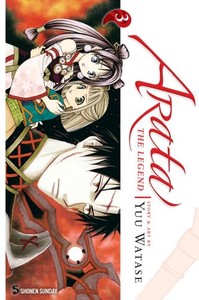Review
by Lissa Pattillo,Arata: The Legend
GN 3
| Synopsis: |  |
||
Hinohara and co. have escaped the prison island and must now make their way back to the Amawakuni capital to stop the conspirators responsible for framing Arata and attempting murder of the Princess. However first they need to travel through land controlled by Kannagi, the man who took his sword to the Princess he once followed. When Hinohara comes down with a fever, they are invited to stay in a village ruled by a kind Sho who works loyally under Kannagi. Soon it becomes apparent that there's more conspiracy at foot then just what they know as Kannagi's men soon become victims of another's plans and everyone's troubles overlap in a brawl of flame and swords. |
|||
| Review: | |||
It's great to finally see some attention given to the Arata now residing in the human world come this third volume of the series. It's a short stint yet still nice to see he wasn't completely forgotten, even if the brief attention feels more intended to scream 'I didn't forget about him!' than to actually progress anything. Then again, comparing some run-ins with bullies to a society-altering magical quest for salvation in another world doesn't exactly feel all that equal on the importance scale. Arata himself takes everything refreshingly in stride, a fantasy-world ignorance that makes him a likeable character as he deals with Hinohara's life as he's dropped into it. No one, Hinohara's family in particular, takes his claims of not being Hinohara seriously, so they just leave him to try and continue on with life as if nothing's wrong. Arata is thusly sent to school to the welcoming jeers of his classmates who heard that he was found naked and wandering in the streets. The bully from Hinohara's past returns with a vengeance, now taking Arata's mere existence personally and vowing to ruin his life. This is left open to offer some more drama later, but for its part here, it's satisfying watching Arata defeat the bully in a physical fight without breaking a sweat. Back in the fantasy world, Hinohara makes it back to land after escaping the prison island with his healer sidekick, Kotoha, and the two boys he met while he was there. A tearful farewell and super plot-convenient appearance of one of the boys' mothers brings the group down to three. The remaining trio soon find themselves in a village where everyone – readers included - learn more about the world's political break down including the introduction of another Sho - the same magical-wielding distinction as Hinohara - and his own little female tag-along, a spunky young girl with a crush on her married master. Suffice to say that whenever main characters regroup in a happy little village that everything's due to hit the fan. Things do and lives are lost and Hinohara gains a somewhat-new perspective on his role here. Like any good hero he puffs out his chest, holds tight his weapon and vows to save the world while standing bright-eyed and hair-flowing atop a cliff side for good measure. The mysterious figure from earlier volumes, who clearly knows more than anyone else, arrives back on scene to give Hinohara the you-wield-a-legendary-weapon-and-will-change-the-world speech while Kotoha makes a refreshingly forward move at the story's end that should de-stale their relationship by a fair bit come volume four. This series has already marked a fairly big change in Yuu Watase's repertoire of shoujo-work it teeters on the line between shoujo and shonen plot elements and appearance. The art style is one of the most noticeable changes, especially with the high contrast inking and busy panels. While the look of the art itself is really impressive, there's still some difficulty telling what's going when the fight scenes really get going. The emotional effects post and prior to the events are as clearly rendered as ever for the artist, but when speed lines start flying and swords start clashing it becomes difficult to tell what's flying where without a few rereads. Unfortunately the same thing can also be said for some of the events leading up to the book's climatic at-end fight scene, when the originally-lead antagonist facing his own betrayals comes racing onto the scene. The story flips back and forth between the gruesome discoveries he makes and what's going on where Hinohara is. When the events collide, what's going on where becomes clear but that's when it blasts into the cluttered fight scenes. You can still tell what's going on in the grand scheme of things, yet it's frustrating having the flow of the story hampered by these coherency issues. This third volume of Arata is a fairly solid continuation of the story but falls short on a lot of elements, making it the weakest of the series to date. It sports some messy execution and stereotypical character progression that feels a step back for Hinohara. Hopefully this is a mere bump in the road, a muddled mass of events to advance the plot that will only be a bump in the road of an otherwise entertaining series. |
|
The views and opinions expressed in this article are solely those of the author(s) and do not necessarily represent the views of Anime News Network, its employees, owners, or sponsors.
|
| Grade: | |||
Overall : C+
Story : C
Art : B+
+ Story takes some time to focus on Arata in the present-day world; story is progressed with a fairly clear path given for what Hinohara has to do and individual aspects of the art are sharp and eye-catching |
|||
| Production Info: | ||
|
Full encyclopedia details about Release information about |
||